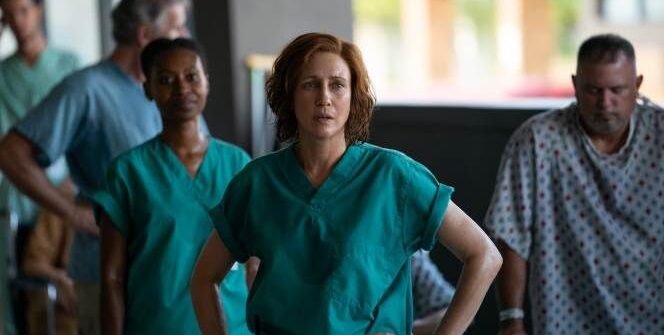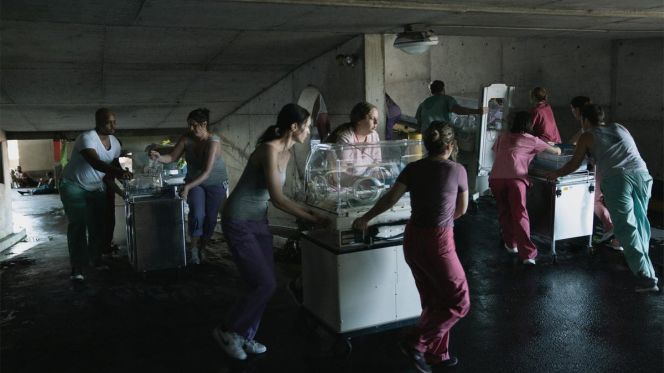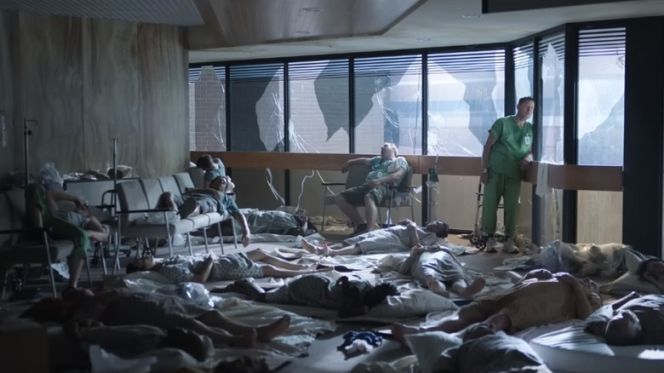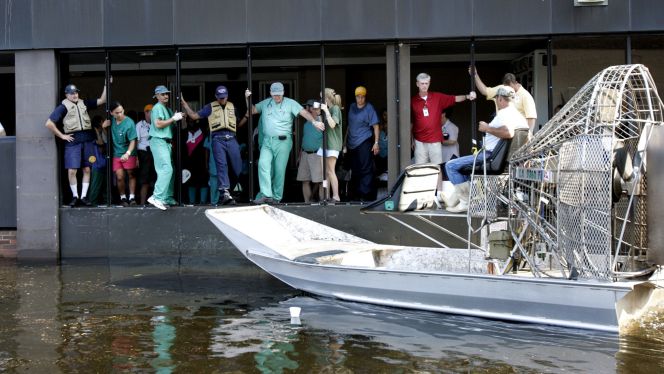SERIES REVIEW – The Apple TV Plus adaptation of Sheri Fink’s documentary book of the same name, Five Days at Memorial, is a miniseries about the five days following Hurricane Katrina’s landfall in New Orleans and the tough decisions of the medical staff at Memorial Medical Center make, often involving life-and-death issues.
Five Days at Memorial is not another ER with charming George Clooney-caliber doctors but a realistic, often harrowing and hard-hitting series based on the documentary by Sheri Fink, set in a hospital that suffered the immediate aftermath of Hurricane Katrina – with horrific consequences. At once, a medical thriller and a gripping disaster story tell the story of an almost hopeless situation based on actual events. Anyone sitting in front of Five Days at Memorial will witness what it was like to be in New Orleans in 2005 when Katriona ravaged the country.
The eight-episode series takes place almost entirely at Memorial Medical Center, the hospital where the hurricane struck on August 29, 2005, and where thousands of patients and staff were staying. By September 11 that year, 45 bodies had been found in the hospital’s chapel. The series details both the increasingly unbearable five days that staff and patients spent in the hospital after Katrina struck and the aftermath, during which the alleged actions of one doctor came under intense public scrutiny.
Slow but inexorable collapse
Vera Farmiga plays Dr. Anna Pou, portrayed here as a thoughtful medical professional who responds to the crisis more quickly than her boss, administrator and the hospital’s incident commander Susan Mulderick (played by the excellent Cherry Jones, who was also the female president of the US for two seasons in 24). Yet both are caught off guard when Katrina lingers beyond the hurricane warnings typical of the region. In the first episode of the series, Dr. Pou brings only a few rations with him, and Susan is shocked to read through the hospital’s emergency manual and find no plans for flood evacuation. What follows is a slow but almost total collapse of society outside the hospital walls, as health workers inside struggle to maintain the dignity and safety of patients in the face of increasingly dire conditions.
Five Days at Memorial tells a tough story. Still, it does not seek to blame anyone but rather to help viewers understand, through realistic scenes, exactly what it must have been like to be in this unimaginable situation. The film humanises the patients and staff alike, but more than anything else it builds up the constantly overwhelming sense of dread by showing the combined weight of all the details that made the situation in the hospital so bad. At first the lifts didn’t work. Then the air conditioning. Then the ventilators stopped working. Corporate offices were unhelpful. The Coast Guard doesn’t seem to be coming either. Shots are heard at night. All these are the thousand little signs of impending disaster and death.
Not intended as mere “entertainment”
As impressive as Five Days at Memorial is, it’s the kind of shocking series you can only watch once. By the fifth episode, which marks the last and deadliest day in hospital, we feel that the series has reached a level of gloom that few other series can compare to. It feels as if Titanic has come to a full climax, or as if Stephen King’s Frank Darabont adaptation of Stephen King’s existential tale The Fog has been stuck in a loop for the last five minutes. Except that, unlike the latter, it’s a true story, which makes it all the more agonising.
Directed by 12 Years a Slave writer John Ridley and former Lost showrunner Carlton Cuse, Five Days at Memorial carries its story through with tremendous visual flair. Although the plot focuses on a single medical centre, the series also successfully creates the visual world of a completely flooded New Orleans. The directors and editors have used a variety of methods to create a sense of realism, combining archival news footage of the situation with special effects recreations of the storm and subsequent dam failures.
The split between reality and fiction
The series loses some of its power in the third episode as it tries to present the investigations of hospital workers while neither denigrating nor glorifying them. The last three episodes focus almost entirely on how the audience understands – or fails to understand – what happened at the hospital during the crisis.
The series presumably deviates from reality in the way it presents the sympathetic, if somewhat incomprehensible, character of Dr Anna Pou in the first episodes. Later, however, when she refers to the investigation into her behaviour as “actual torture”, soon after we have seen her patients and colleagues endure genuinely torturous conditions, this judgement seems recklessly self-serving. Rather than explaining his motives more clearly, the series makes them even more confusing in the eleventh hour. In addition, Five Days in the Hospital never really resolves the apparent contradictions between Dr. Pou and another doctor, while at the same time dwelling on them too long for the viewer to be satisfied with ambiguity.
A catastrophe made by men
On the other hand, the makers of Five Days in the Hospital clearly do a better job of showing the multi-level failure of the US government and infrastructure that has resulted in so many Katrina deaths. As a natural disaster story, that would be shocking enough. Yet the series is so compelling because it perfectly recognises that Katrina was, after all, a catastrophe made by men. The breakdown in coordination and communication between government, corporations and even the hospital itself had tragic consequences for human lives.
It is impossible to watch the eight episodes of Five Days in the Hospital without wondering what decisions we would make in such a situation or how often human resilience must overcome institutional inertia to survive such a disaster. Yet this is not a hopeful series with a positive outcome but a starkly realistic one that uses real, tragic events to tell a more complex, existential story of ordinary people stretched to their physical and moral limits.
-BadSector-
Five Days at Memorial
Direction - 8.2
Actors - 8.2
Story - 7.2
Visuals/Music/Sounds - 8.2
Ambience - 7.2
7.8
GOOD
It is impossible to watch the eight episodes of Five Days in the Hospital without wondering what decisions we would make in such a situation or how often human resilience must overcome institutional inertia to survive such a disaster. Yet this is not a hopeful series with a positive outcome but a starkly realistic one that uses real, tragic events to tell a more complex, existential story of ordinary people stretched to their physical and moral limits.

















Leave a Reply